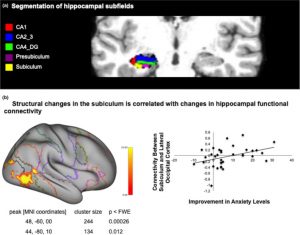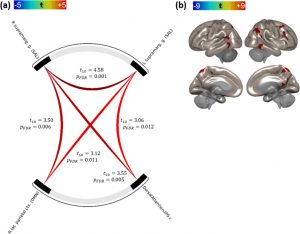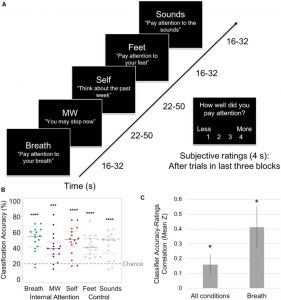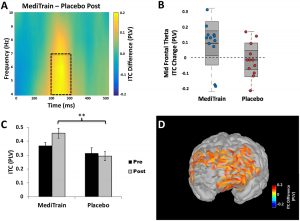Change the Brain to Reduce Anxiety with Mindfulness
By John M. de Castro, Ph.D.
“Mindfulness can enhance our ability to remember this new, less-fearful reaction, and break the anxiety habit.” It’s a tool that interrupts those old, fear-inducing memories, and creates new, less threatening associations in the mind.” – Nate Klemp
Meditation training has been shown to improve health and well-being. It has also been found to be effective for a large array of medical and psychiatric conditions, either stand-alone or in combination with more traditional therapies. There are a number of ways that meditation practices produce these benefits, including changes to the brain and physiology. The nervous system is a dynamic entity, constantly changing and adapting to the environment. It will change size, activity, and connectivity in response to experience. These changes in the brain are called neuroplasticity. Over the last decade neuroscience has been studying the effects of contemplative practices on the brain and has identified neuroplastic changes in widespread areas. In other words, meditation practice appears to mold and change the brain, producing psychological, physical, and spiritual benefits.
In today’s Research News article “). Hippocampal circuits underlie improvements in self-reported anxiety following mindfulness training.” (See summary below or view the full text of the study at: https://www.ncbi.nlm.nih.gov/pmc/articles/PMC7507558/ ) Sevinc and colleagues recruited healthy adults and randomly assigned them to receive weekly 2-hour sessions of either stress management education or Mindfulness-Based Stress Reduction (MBSR) along with 40-minutes of daily home practice. The stress management education consisted of discussion of sources of stress and light exercise. MBSR consisted of discussion, meditation, body scan, and yoga practices. They were measured before and after training for perceived stress, mindfulness, and anxiety.
All participants underwent classical fear conditioning with 2 different light colors presented just prior to an irritating shock to the finger and a third color light not followed by shock. The conditioning was then extinguished for one light color but not the other by repeated presentations of the light without shock. After training the participants underwent brain scanning focused on the subfields of the hippocampus with functional Magnetic Resonance Imaging (fMRI). The size of the hippocampal subfields was measured along with the connectivity between the hippocampus and other brain areas while the participants were shown the different colored lights used in the fear conditioning.
They found that after Mindfulness-Based Stress Reduction (MBSR) there was an increase in the volume of the hippocampal subfield of the subiculum. They also found a decrease in the connectivity of the hippocampus with the occipital cortex during presentation of the extinguished fear conditioning lights. In addition, they found that the greater the increase in volume of the subiculum, the greater the decrease in anxiety levels after MBSR.
The subiculum has been implicated in memory consolidation and retrieval. So, the increased volume detected after Mindfulness-Based Stress Reduction (MBSR) suggests that MBSR improves the memory process. Indeed, mindfulness training has previously been shown to improve memory processes. The decrease in hippocampal connectivity during extinction recall after MBSR training suggests that the individual may be better able to ignore previously associated fear stimuli. This could well underlie a reduction in anxiety by not responding to fear stimuli that are no longer associated with frightening circumstances. This may be a mechanism that, at least in part, underlies the ability of mindfulness training to improve post-traumatic stress disorder (PTSD). Regardless, the results suggest that mindfulness training alters the brain in such a way to reduce anxiety.
So, change the brain to reduce anxiety with mindfulness.
“In mindfulness practice . . . you have an opportunity—the mental time and space, if you will—to see more elements of the story, a richer picture. “You may see more clearly as you anticipate a difficult encounter what the underlying emotion is that’s triggered and how it’s showing up in your body.” – Barry Boyce
CMCS – Center for Mindfulness and Contemplative Studies
This and other Contemplative Studies posts are also available on Google+ https://plus.google.com/106784388191201299496/posts and on Twitter @MindfulResearch
Study Summary
Sevinc, G., Greenberg, J., Hölzel, B. K., Gard, T., Calahan, T., Brunsch, V., Hashmi, J. A., Vangel, M., Orr, S. P., Milad, M. R., & Lazar, S. W. (2020). Hippocampal circuits underlie improvements in self-reported anxiety following mindfulness training. Brain and behavior, 10(9), e01766. Advance online publication. https://doi.org/10.1002/brb3.1766
Abstract
Introduction
Mindfulness meditation has successfully been applied to cultivate skills in self‐regulation of emotion, as it employs the unbiased present moment awareness of experience. This heightened attention to and awareness of sensory experience has been postulated to create an optimal therapeutic exposure condition and thereby improve extinction learning. We recently demonstrated increased connectivity in hippocampal circuits during the contextual retrieval of extinction memory following mindfulness training.
Methods
Here, we examine the role of structural changes in hippocampal subfields following mindfulness training in a randomized controlled longitudinal study using a two‐day fear‐conditioning and extinction protocol.
Results
We demonstrate an association between mindfulness training‐related increases in subiculum and decreased hippocampal connectivity to lateral occipital regions during contextual retrieval of extinguished fear. Further, we demonstrate an association between decreased connectivity and decreases in self‐reported anxiety following mindfulness training.
Conclusions
The results highlight the role of the subiculum in gating interactions with contextual stimuli during memory retrieval and, also, the mechanisms through which mindfulness training may foster resilience.
Abstract
Mindfulness meditation has successfully been applied to cultivate skills in self‐regulation of emotion, as it employs the unbiased present moment awareness of experience. This heightened attention to and awareness of sensory experience has been postulated to create an optimal therapeutic exposure condition and thereby improve extinction learning. Here, we examine the role of structural changes in hippocampal subfields and further demonstrate an association between mindfulness training‐related increases in subiculum and decreased hippocampal connectivity to lateral occipital regions during contextual retrieval of extinguished fear. Further, we demonstrate an association between decreased connectivity and decreases in self‐reported anxiety following mindfulness training. These results highlight the role of the subiculum in gating interactions with contextual stimuli during memory retrieval and, also, the mechanisms through which mindfulness training fosters resilience.
https://www.ncbi.nlm.nih.gov/pmc/articles/PMC7507558/









